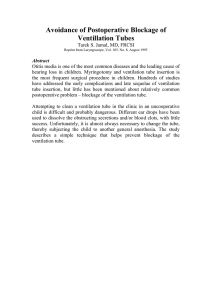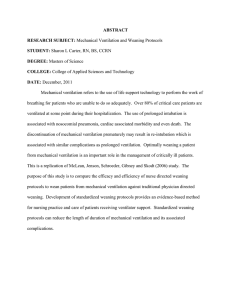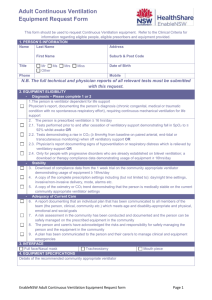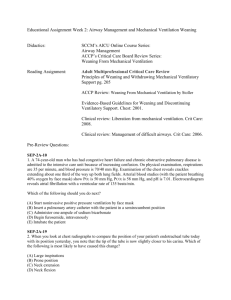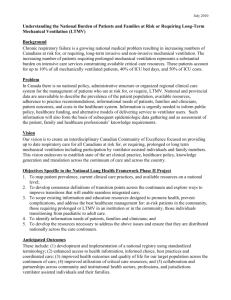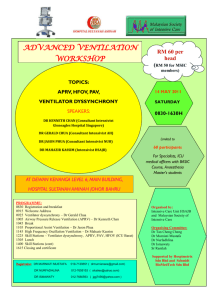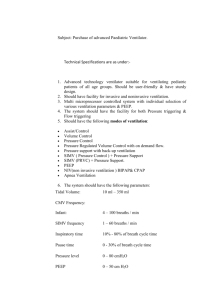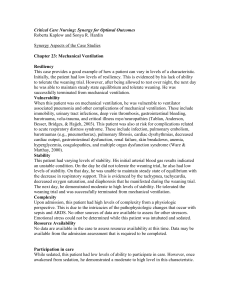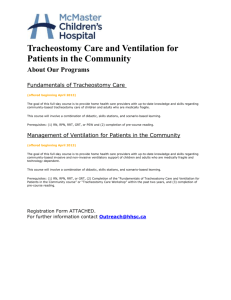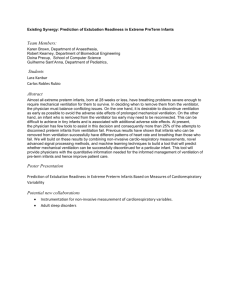Ventilator Weaning in the patient with TBI
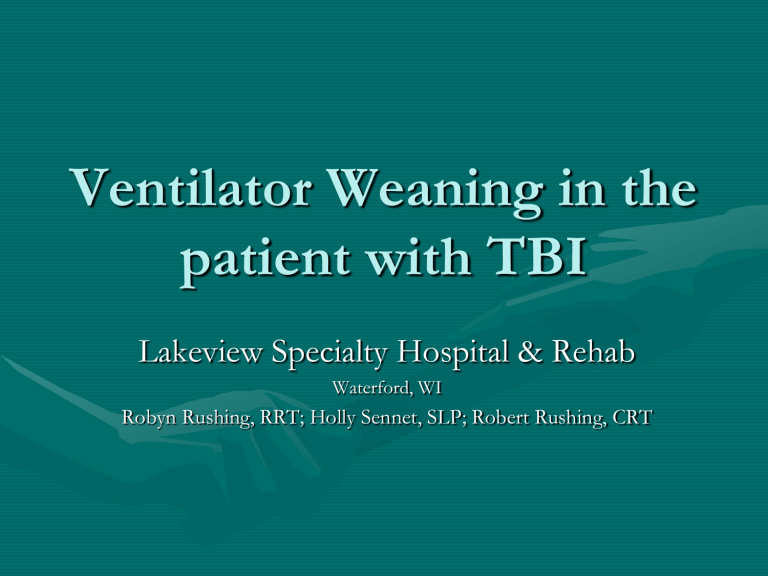
Ventilator Weaning in the patient with TBI
Lakeview Specialty Hospital & Rehab
Waterford, WI
Robyn Rushing, RRT; Holly Sennet, SLP; Robert Rushing, CRT
Our Goal
• Patients who have suffered from moderate to severe
TBI are often transferred from an ICU or acute hospital setting to a Long Term Acute Care or
Rehabilitation Hospital for ventilator weaning, medical stabilization, rehabilitation and optimum discharge planning to a “home” environment.
• We would like to share with you some of our successes in this area and highlight the TEAM Multi-disciplinary approach that has been utilized in our facilities for the last 2 years that has had excellent sustained outcomes.
Definition of Traumatic Brain Injury
• Traumatic brain injury is defined as damage to the brain resulting from external mechanical force, such as rapid acceleration or deceleration, impact, blast waves, or penetration by a projectile.
• Brain function is temporarily or permanently impaired and structural damage may or may not be detectable with current technology.
Mechanical Ventilation Definitions
• Definition: Mechanical ventilation is life-supporting ventilation that involves the use of a machine called a ventilator, or respirator. The goal of mechanical ventilation is to support breathing when a patient is no longer able to do so effectively on their own. Mechanical ventilation is generally the last resort when a patient is having difficulty breathing and cannot maintain adequate oxygenation.
• When a patient requires mechanical ventilation, a tube is inserted into the throat by a process called intubation. The (ET) tube extends down the trachea and into the lungs and is connected to outside plastic tubing that hooks up to the ventilator.
• In prolonged ventilation the ET tube may be replaced by a tracheostomy. A tracheostomy is a procedure that creates an opening through the neck into the airway through which a tube is placed. The tube, called a tracheostomy tube, allows air to flow into the lungs and allows the airways to be suctioned.
Therapist Driven Protocols
• Patient Driven Protocol
• Assessment Protocol
• Ventilation Protocol
– Invasive
– Non-invasive
• Conservative ventilation parameters
– Minimizing pressure and lung injury
– Improving oxygenation
Multi-Disciplinary Approach
• Therapies
– PT – Vent mobilization protocol
– OT – Resuming ADL function asap
– SLP – Evaluation, Communication, Swallowing and
Education
Combining the Processes
• Weaning Protocol – advanced
• Early ambulation – advanced equipment and therapies
• Regaining H.O.P.E.
– Healing
– Objective
– Persistence
– Encouragement
• Positive Engagement
– Care Givers
– Family
– Patient
Communication is Key
• Cognitive and Speech Therapy – The core of the patient
• Giving the patient a voice
– Patience is instrumental in achieving positive feedback
• Speaking valve
– Passy-Muir
• Dynavox
– Portable augmentative and alternative communication device. This electronic speech generating device enables those who are unable to speak the ability to communicate using text, symbols and audio playback.
• iPad Applications for communication, swallow and education
– Phrase Board
– Verbally
– Speak IT
– Assisted Chat
– Dysphasia
Supporting Roles
• Pharmacy
– Effective Sedation
– Role of the clinical pharmacist (PharmD)
– Stress, agitation and pain
• Nutrition
– CO
2
Monitoring
– Carbohydrates
– Electrolytes
– Protein
• Psychology
– Patient
– Family
• Case Management/Discharge Planning
Case Study Discussion
• Male patient
– Ventilator
– Trach
– Oxygen demands
– Vocal cord paralysis
• Every case is unique
Success!
• The commonality is our humanity
• This work is a calling…..not for everyone…but absolutely rewarding
• Thank you for doing what you do to change the lives of others. It is a worthwhile pursuit…and worthy of recognition!
